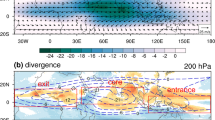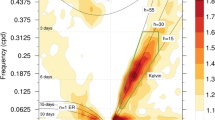Abstract
Abundant mixed-phase clouds exist over the Arctic and the Tibetan Plateau. Salient differences in their seasonal cycle and in their vertical structure and cloud radiative effects (CREs, which includes shortwave CRE, longwave CRE and net CRE) imply different influences on the climate system. The maximum incidence of mixed-phase clouds appears during the late spring and early winter over the Arctic Ocean, but it appears during the summer over the Tibetan Plateau. The surface mixed-phase-cloud-induced CRE exerts a strong warming effect over the Arctic during the cold season (from September to May), in contrast to the strong cooling effect over the Tibetan Plateau during the summer. The existence of temperature inversion over the Arctic Ocean confines the mixed-phase clouds and associated cloud hydrometeors and vertical radiative heating profile at the near surface, while over the Tibetan Plateau there is no such a temperature inversion, and hence the cloud-induced atmospheric heating profile exhibits both larger vertical contrast and more seasonal variation over the Tibetan Plateau.








Similar content being viewed by others
Data availability
All the satellite data used in this study were obtained from http://www.cloudsat.cira.colostate.edu/order-data (last access: 29 December 2018).
References
Austin R (2007) Level 2B radar-only cloud water content (2B-CWC-RO) process description document. CloudSat Project Report. http://www.cloudsat.cira.colostate.edu/data-products/level-2b/2b-cwc-ro?term=28. Accessed 23 Apr 2019
Bintanja R, Graversen RG, Hazeleger W (2011) Arctic winter warming amplified by the thermal inversion and consequent low infrared cooling to space. Nat Geosci 4:758–761
Collins M, Knutti R, Arblaster J, Dufresne JL, Fichefet T, Friedlingstein P, Gao X, Gutowski WJ, Johns T, Krinner G, Shongwe M, Tebaldi C, Weaver AJ, Wehner M (2013) Long-term climate change: projections, commitments and irreversibility. Climate Change 2013: The physical science basis. Contribution of working group I to the fifth assessment report of the Intergovernmental Panel on Climate Change. Cambridge University Press, Cambridge, pp 1029–1136. https://doi.org/10.1017/CBO9781107415324.024
Costa A, Meyer J, Afchine A, Luebke A et al (2017) Classification of Arctic, midlatitude and tropical clouds in the mixed-phase temperature regime. Atmos Chem Phys 17:12219–12238
Duan AM, Wu GX (2005) Role of the Tibetan Plateau thermal forcing in the summer climate patterns over subtropical Asia. Clim Dyn 24(7–8):793–807
Engström A, Karlsson J, Svensson G (2014) The importance of representing mixed-phase clouds for simulating distinctive atmospheric states in the Arctic. J Clim 27:265–272
Henderson D, Ecuyer TL, Vane D, Stephens G, Reinke D (2011) Level 2B fluxes and heating rates and 2B fluxes and heating rates w/Lidar process description and interface control document (Version 1.0). CloudSat Project Report. http://www.cloudsat.cira.colostate.edu/data-products/level-2b/2b-flxhr-lidar?term=38. Accessed 23 Apr 2019
Heymsfield AJ, Protat A, Austin RT, Bouniol D, Hogan RJ, Delanoe J, Okamoto H, Sato K, Zadelhoff JG, Donovan DP, Wang Z (2008) Testing IWC retrieval methods using radar and ancillary measurements with in situ data. J Appl Meteorol Clim 47:135–163
Hoskins BJ (1991) Towards a PV-θ view of the general circulation. Tellus 43:27–35
Hoskins BJ (2015) Potential vorticity and the PV perspective. Adv Atmos Sci 32:2–9
Hu Y, Rodier S, Xu K, Sun W, Huang J, Lin B, Zhai P, Josset D (2010) Occurrence, liquid water content, and fraction of supercooled water clouds from combined CALIOP/IIR/MODIS measurements. J Geophys Res 115:D00H34
Karlsson J, Svensson G (2013) Consequences of poor representation of Arctic sea–ice albedo and cloud–radiation interactions in the CMIP5 model ensemble. Geophys Res Lett 40:4374–4379
Kaul CM, Teixeira J, Suzuki K (2015) Sensitivities in large-eddy simulations of mixed-phase Arctic stratocumulus clouds using a simple microphysics approach. Mon Weather Rev 143:4393–4421
Lawson RP, Gettelman A (2014) Impact of Antarctic clouds on climate. Proc Natl Acad Sci USA 111:18156–18161
Liu Y, Bao Q, Duan A, Qian Z, Wu G (2007) Recent progress in the impact of the Tibetan Plateau on climate in China. Adv Atmos Sci 24:1060–1076
Lohmann U, Henneberger J, Henneberg O, Fugal JP, Bühl J, Kanji ZA (2016) Persistence of orographic mixed-phase clouds. Geophys Res Lett 43:10512–10519
Lu J, Cai M (2009) Seasonality of polar surface warming amplification in climate simulations. Geophys Res Lett 36:L16704
Mace G (2007) Level 2 GEOPROF product: process description and interface control document algorithm, version 5.3. CloudSat Project Report. http://www.cloudsat.cira.colostate.edu/data-products/level-2b/2b-geoprof?term=42. Accessed 23 Apr 2019
Matus AV, L’Ecuyer TS (2017) The role of cloud phase in Earth’s radiation budget. J Geophys Res Atmos 122:2559–2578
Mlawer EJ, Taubman SJ, Brown PD, Iacono MJ, Clough SA (1997) RRTM, a validated correlated-k model for the longwave. J Geophys Res 102:16663–16682
Moritz RE, Bitz CM, Steig EJ (2002) Dynamics of recent climate change in the Arctic. Science 297:1497–1502
Morrison H, de Boer G, Feingold G, Harrington J, Shupe MD, Sulia K (2012) Resilience of persistent Arctic mixed-phase clouds. Nat Geosci 5:11–17
Neggers RAJ, Chylik J, Egerer U et al (2019) Local and remote controls on Arctic mixed-layer evolution. J Adv Model Earth Syst 11:2214–2237
Pithan F, Medeiros B, Mauritsen T (2014) Mixed-phase clouds cause climate model biases in Arctic wintertime temperature inversions. Clim Dyn 43:289–303
Ramanathan V, Cess RD, Harrison EF, Minnis P, Barkstrom BR, Ahmad E, Hartmann D (1989) Cloud-radiative forcing and climate: results from the Earth radiation budget experiment. Science 243:57–63
Rangwala I, Sinsky E, Miller JR (2013) Amplified warming projections for high altitude regions of the Northern Hemisphere mid-latitudes from CMIP5 models. Environ Res Lett 8:024040
Sedlar J, Shupe MD (2014) Characteristic nature of vertical motions observed in Arctic mixed-phase stratocumulus. Atmos Chem Phys 14:3461–3478. https://doi.org/10.5194/acp-14-3461-2014
Shupe MD, Intrieri JM (2004) Cloud radiative forcing of the Arctic surface: the influence of cloud properties, surface albedo, and solar zenith angle. J Clim 17:616–628
Solomon A, Shupe MD, Persson O, Morrison H, Yamaguchi T, Caldwell PM, Boer GD (2014) The sensitivity of springtime Arctic mixed-phase stratocumulus clouds to surface layer and cloud-top inversion layer moisture sources. J Atmos Sci 71:574–595
Stephens GL, Vane DG, Boain RJ et al (2002) The Cloudsat mission and the A-Train: a new dimension to space-based observations of clouds and precipitation. Bull Am Meteorol Soc 83(12):1771–1790
Su J, Duan A, Xu H (2017) Quantitative analysis of surface warming amplification over the Tibetan Plateau after the late 1990s using surface energy balance equation. Atmos Sci Lett 18:112–117
Tjernström M, Graversen RG (2009) The vertical structure of the lower Arctic troposphere analysed from observations and the ERA-40 reanalysis. Q J R Meteorol Soc 135:431–443
Vavrus S (2004) The impact of cloud feedbacks on Arctic climate under greenhouse forcing. J Clim 17:603–615
Wendisch M, Macke A, Ehrlich A, Lüpkes C et al (2018) The Arctic cloud puzzle: using ACLOUD/PASCAL multi-platform observations to unravel the role of clouds and aerosol particles in Arctic amplification. Bull Am Meteorol Soc 100:841–872
Winker DM, Hunt WH, McGill MJ (2007) Initial performance assessment of CALIOP. Geophys Res Lett 34:L19803
Wu GX, Zhang YS (1998) Tibetan Plateau forcing and the timing of the monsoon onset over South Asia and the South China Sea. Mon Weather Rev 126(4):913–927
Yan Y, Liu Y, Lu J (2016) Cloud vertical structure, precipitation, and cloud radiative effects over Tibetan Plateau and its neighboring regions. J Geophys Res Atmos 121:5864–5877
Zuidema P, Baker B, Han Y, Intrieri J, Key J, Lawson P et al (2005) An Arctic springtime mixed-phase cloudy boundary layer observed during SHEBA. J Atmos Sci 62:160–176
Acknowledgements
This work was supported by the strategic Priority Research Program of the Chinese Academy of Sciences (Grant no. XDA19070404). It was also supported by National Natural Science Foundation of China (Grant no. 41875130). Two anonymous reviewers are appreciated for their constructive comments.
Author information
Authors and Affiliations
Contributions
JL: initiated the idea of comparison between clouds over the TP and that over the Arctic; YY and XL: performed the diagnostics of CloudSat/CALIPSO data; YY: performed the calculation of radiative fluxes based on the RRTM; JL and YY: wrote the manuscript; JL and YL: supervised the diagnostics.
Corresponding author
Ethics declarations
Conflict of interest
The authors declare that they have no conflict of interest.
Additional information
Publisher's Note
Springer Nature remains neutral with regard to jurisdictional claims in published maps and institutional affiliations.
Rights and permissions
About this article
Cite this article
Yan, Y., Liu, X., Liu, Y. et al. Comparison of mixed-phase clouds over the Arctic and the Tibetan Plateau: seasonality and vertical structure of cloud radiative effects. Clim Dyn 54, 4811–4822 (2020). https://doi.org/10.1007/s00382-020-05257-8
Received:
Accepted:
Published:
Issue Date:
DOI: https://doi.org/10.1007/s00382-020-05257-8




